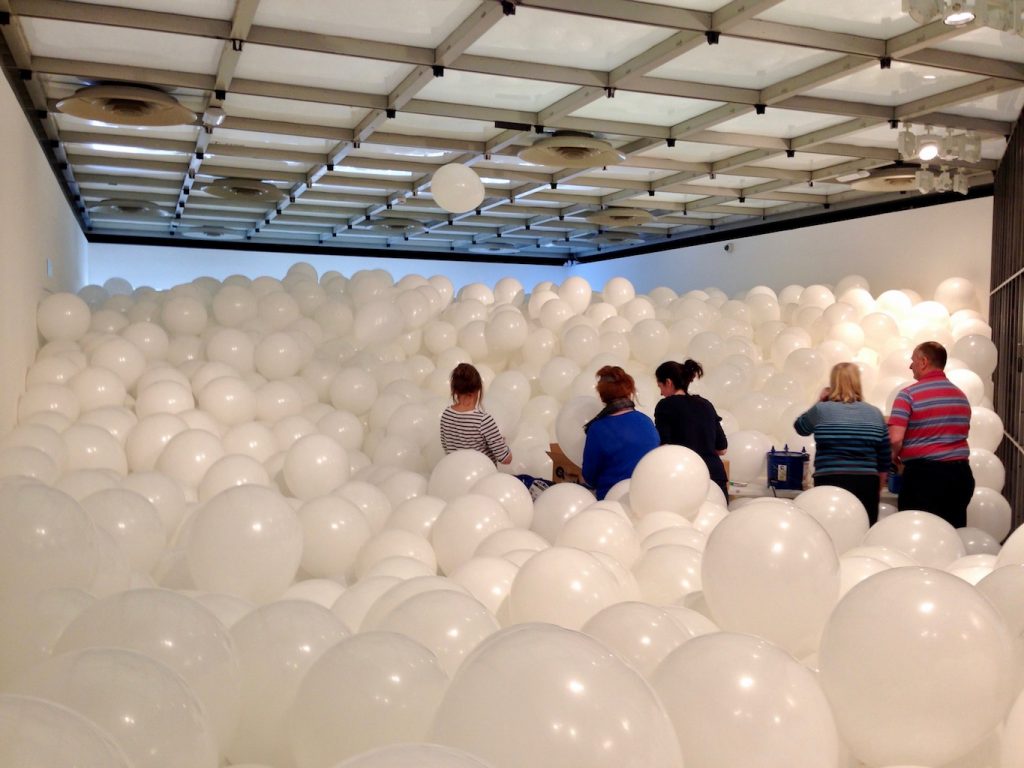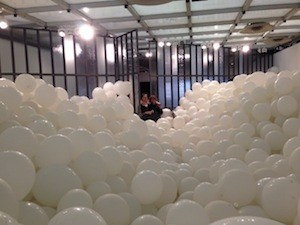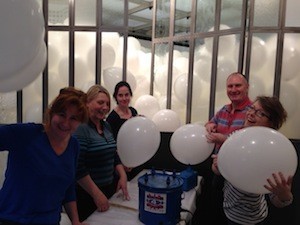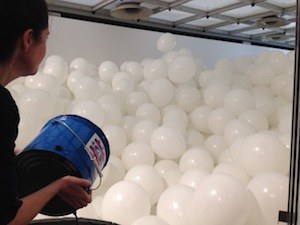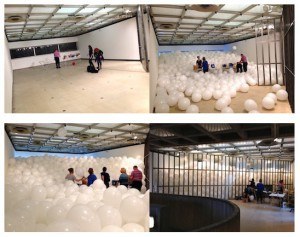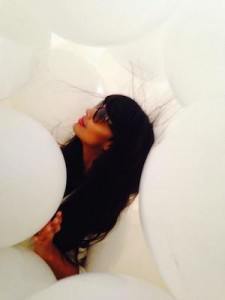When The Haywood Gallery wanted a space filled with balloons for a 4 month period we thought it sounded like fun. We were building a work of art in a gallery, for people to walk though. However, over the time period keeping the space filled and clean was not easy.
The original spec was simple, the artist had calculated the number of 16″ balloons required to half fill the space and we were simply asked to inflate 7000 latex. This had been done before in galleries around the world and Qualatex had supplied the balloons. The gallery ordered 20,000 x 16″ and we only needed to supply staff to inflate them.
It sounds simple enough but firstly I know from experience that 16″ are not easy to tie, I calculated that it would take 4 experianced crew all day. The problem was finding 4 people who could tie 16″ – it’s all very well tying 50 but not so easy to tie nearly 2000 each. As the inflation day approached I decided to go for 3 lesser experienced staff to simply inflate and 2 or 3 really good balloon professionals who can work through the pain barrier.
Qualatex were also very generous and lent me a staff member for the day – Nick Meggison who had supplied the gallery with the 16″
Before the inflation day we were asked if it was possible to size all the balloons to 14.5″. I explained that because of the speed we were going to work this just wouldn’t be possible. I suggested that we size the first 20 or so to get a rough idea for 14.5″.
On the day of inflation the key was the first 2 hours, if we could inflate more than 1000 an hour then the day would be easy. If we failed then basically I would be in the Gallery at 9pm still working. Anyway…… everything went to plan and we were finished at 4pm even with a lunch break.
The objective was to half fill the space, this meant filling the room to 2.2 meters high which was above head height. Visitors walked very slowly though the area to experiance the space, it was a fantastic sensation and became the most popular exhibit within the exhibition. As the days went on and some of the latex burst or reduced in size the height began to lower. When visitors could see above the 16″ they began running and jumping around the area and so bursting more and more.
The below vine is a great example of what it was like in the room:
https://youtu.be/1FXCxl37FhI?t=16m4s
During the first week more than 70% had burst. People were visiting the gallery especially to go into the balloon room and queued around the area blocking the view to other exhibits. This was the first issue for us and the gallery as nobody had expected this many to disappear in just 7 days. That’s when it became clear that the 20,000 Qualatex ordered would not be enough to last 4 months. The same exhibit had been installed in St.Ives and they had only experinced a 10% weekly burstage rate, it seemed that because we were in London the footfall was greater and therefore we were losing more. 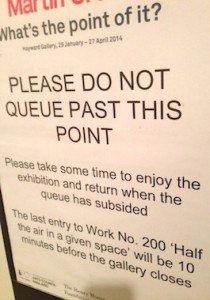 I calculated that at least 50,000 were required if we were to maintain the room fill for 4 months (in the end we used 90,000). This meant a shipment from the States with a delay of 3 weeks as there simply weren’t enough 16″ White in the UK. I suggested we switch colour to maybe Red but this was not the artists selected colour – it had to be White. To fill the 3 week time gap I recommeneded Belbal and they suppled 12,000 in just a few days which gave us a good cushion going forward. As the burstage rate bedded in, we were asked to visit every Saturday night and Monday morning for the remaining time the exhibition was on. The gallery tech crew inflated a few hundred during the week to keep the room topped up.
I calculated that at least 50,000 were required if we were to maintain the room fill for 4 months (in the end we used 90,000). This meant a shipment from the States with a delay of 3 weeks as there simply weren’t enough 16″ White in the UK. I suggested we switch colour to maybe Red but this was not the artists selected colour – it had to be White. To fill the 3 week time gap I recommeneded Belbal and they suppled 12,000 in just a few days which gave us a good cushion going forward. As the burstage rate bedded in, we were asked to visit every Saturday night and Monday morning for the remaining time the exhibition was on. The gallery tech crew inflated a few hundred during the week to keep the room topped up. 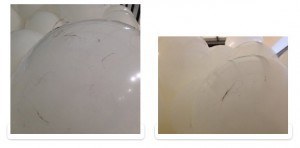 As visitors moved though the area the static built and the room became a magnet for hair. After a few weeks we had to replenish the room from scratch – burst everything, clean the area and re-inflate another 7000. This was tricky as the gallery opened 7 days a week, it opened slightly later on Mondays so our optimum time was 5am – 12pm. For the first 5 weeks nobody wrote on a balloon. We then started to find a few pictures and messages and it seemed more and more visitors wanted to write or draw something. Even after we reset the room it seemed the word had spread and visitors must have been entering the room with their pens ready.
As visitors moved though the area the static built and the room became a magnet for hair. After a few weeks we had to replenish the room from scratch – burst everything, clean the area and re-inflate another 7000. This was tricky as the gallery opened 7 days a week, it opened slightly later on Mondays so our optimum time was 5am – 12pm. For the first 5 weeks nobody wrote on a balloon. We then started to find a few pictures and messages and it seemed more and more visitors wanted to write or draw something. Even after we reset the room it seemed the word had spread and visitors must have been entering the room with their pens ready. 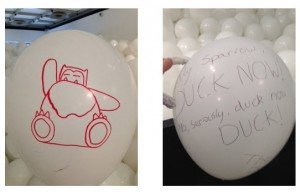 The technical team at the gallery built tools specifically for bursting. When the room was reset it would take 2 hours of bursting to clear the area, they started at either end so not to risk injuring each other.
The technical team at the gallery built tools specifically for bursting. When the room was reset it would take 2 hours of bursting to clear the area, they started at either end so not to risk injuring each other.  We moved out of the room as late as we could and then closed the door to a 3ft gap and threw the balloons in to really fill the space.
We moved out of the room as late as we could and then closed the door to a 3ft gap and threw the balloons in to really fill the space.  Bursting the dirty balloons was not a nice job. The technical team covered their clothes, wore masks and pushed themselves around on wheels as they tried to keep the area clean. Over the 4 months 2 wedding rings were recovered, an iphone, several oyster cards, wallets and a bracelet.
Bursting the dirty balloons was not a nice job. The technical team covered their clothes, wore masks and pushed themselves around on wheels as they tried to keep the area clean. Over the 4 months 2 wedding rings were recovered, an iphone, several oyster cards, wallets and a bracelet.
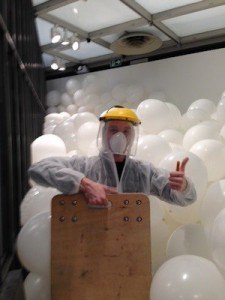
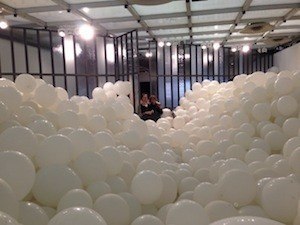
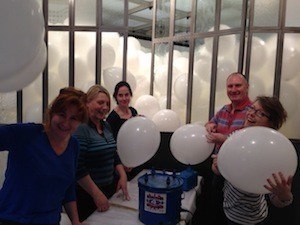
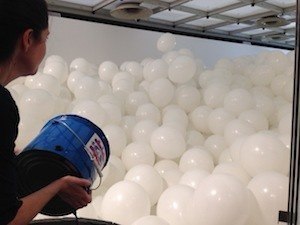
 The above shows some of the crew that worked thoughout the 4 months – thanks to Alex & Meesh who worked on just about every refill and reset and to Paul Muffet who was bullet proof on early starts. You can also see Alex making some space for another 1000 x 16″ on a standard Monday top up…… and her thoughts on inflating 90,000 boxed balloons. Thanks to Dave Crossley from Creative Balloons who worked on the first installation, his fingers literally looked like they had been hit with a hammer. He was unable to tie for the following 2 weeks, he eventually got back to work but used a golf glove. Here’s a vine of us filling the room:
The above shows some of the crew that worked thoughout the 4 months – thanks to Alex & Meesh who worked on just about every refill and reset and to Paul Muffet who was bullet proof on early starts. You can also see Alex making some space for another 1000 x 16″ on a standard Monday top up…… and her thoughts on inflating 90,000 boxed balloons. Thanks to Dave Crossley from Creative Balloons who worked on the first installation, his fingers literally looked like they had been hit with a hammer. He was unable to tie for the following 2 weeks, he eventually got back to work but used a golf glove. Here’s a vine of us filling the room:
A couple of the best tweeted photos from visitors:
Other links:
TimeOut article on the balloon room & our Google+ gallery


